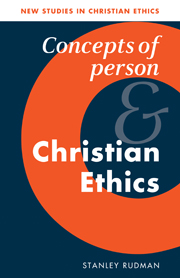Book contents
- Frontmatter
- Contents
- General editor's preface
- Acknowledgements
- List of abbreviations
- Introduction
- PART I ‘PERSON’ IN CONTEMPORARY ETHICS
- 1 ‘Une catégorie de l'esprit humain: la notion de personne’
- 2 Meaning and criteria: person/human being
- 3 Moral personhood in M. Tooley and P. Singer
- 4 Personal identity and responsibility in D. Parfit
- 5 Human subject and human worth
- 6 Resituating personhood: embodiment and contextuality
- PART 2 ‘PERSON’ IN CHRISTIAN PERSPECTIVE
- PART 3 IMPLICATIONS FOR A CHRISTIAN ETHIC
- Conclusion
- Notes
- Select bibliography
- Index of subjects
- Index of names
6 - Resituating personhood: embodiment and contextuality
Published online by Cambridge University Press: 02 December 2009
- Frontmatter
- Contents
- General editor's preface
- Acknowledgements
- List of abbreviations
- Introduction
- PART I ‘PERSON’ IN CONTEMPORARY ETHICS
- 1 ‘Une catégorie de l'esprit humain: la notion de personne’
- 2 Meaning and criteria: person/human being
- 3 Moral personhood in M. Tooley and P. Singer
- 4 Personal identity and responsibility in D. Parfit
- 5 Human subject and human worth
- 6 Resituating personhood: embodiment and contextuality
- PART 2 ‘PERSON’ IN CHRISTIAN PERSPECTIVE
- PART 3 IMPLICATIONS FOR A CHRISTIAN ETHIC
- Conclusion
- Notes
- Select bibliography
- Index of subjects
- Index of names
Summary
The aim of this chapter is to suggest some modification of Kant's understanding of personhood in terms of rationality by looking at the response of two different currents of thought to issues of personhood: theistic personalism and feminism. As examples of the former, we have taken Boston personalism and E. Mounier's personalism, and, as examples of the latter, we consider feminist attempts to move away from privileged rationality and the attempt of Seyla Benhabib to combine Habermas' goal of undistorted communication with a view of the self as gendered and embodied. They have their own different concerns, but are related by their search for ways of understanding personhood ethically and with more attention to human relationships than Kant gave. They also have an interest in seeing persons as members of community. Separately they may appear slight and even philosophically insignificant compared with Kant, but together they point to a richer alternative.
We have argued in chapter 5 that Kant's account of ‘persons’ contains confusion and error, in that it conflates persons as ‘ends in themselves’ with persons as ‘rational’ (cf. Grundlegung 95-6/428 and 102-5) In these passages, as elsewhere, Kant seems to equivocate between person as potentially rational and person as actually rational. In either case, it seems that Kant has begun to replace the view that persons are ends in themselves with the view that rational persons or potentially rational persons are ends in themselves.
- Type
- Chapter
- Information
- Concepts of Person and Christian Ethics , pp. 103 - 118Publisher: Cambridge University PressPrint publication year: 1997



